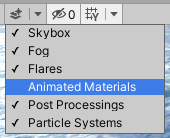4. Wave Conditions¶
The following sections describe how to define the wave conditions.
Tip
It is useful to see the animated ocean surface while tweaking the wave conditions.
By default, the update speed is intentionally throttled by Unity to save power when in edit mode. To enable real-time update, enable Animated Materials in the Scene View toggles:

See the Unity Documentation for more information.
4.1. Authoring¶
To add waves, add the ShapeGerstnerBatched component to a GameObject.
The appearance and shape of the waves is determined by a Wave Spectrum. A default wave spectrum will be created if none is specified. To change the waves, right click in the Project view and select Create/Crest/Ocean Wave Spectrum, and assign the new asset to the Spectrum property of the ShapeGerstnerBatched script.
The spectrum has sliders for each wavelength to control contribution of different scales of waves. To control the contribution of 2m wavelengths, use the slider labelled ‘2’.
The Wave Direction Variance controls the spread of wave directions. This controls how aligned the waves are to the wind direction.
The Chop parameter scales the horizontal displacement. Higher chop gives crisper wave crests but can result in self-intersections or ‘inversions’ if set too high, so it needs to be balanced.
To aid in tweaking the spectrum values we provide implementations of common wave spectra from the literature. Select one of the spectra by toggling the button, and then tweak the spectra inputs, and the spectrum values will be set according to the selected model. When done, toggle the button off to stop overriding the spectrum.
Together these controls give the flexibility to express the great variation one can observe in real world seascapes.
4.2. Local Waves¶
By default the Gerstner waves will apply everywhere throughout the world, so ‘globally’. They can also be applied ‘locally’ - in a limited area of the world.
This is done by setting the Mode to Geometry. In this case the system will look for a MeshFilter/MeshRenderer on the same GameObject and it will generate waves over the area of the geometry. The geometry must be ‘face up’ - it must be visible from a top-down perspective in order to generate the waves. It must also have a material using the Crest/Inputs/Animated Waves/Gerstner Batch Geometry shader applied.
For a concrete example, see the GerstnerPatch object in boat.unity. It has a MeshFilter component with the Quad mesh applied, and is rotated so the quad is face up. It has a MeshRenderer component with a material assigned with a Gerstner material.
The material has the Feather at UV Extents option enabled, which will fade down the waves where the UVs go to 0 or 1 (at the edges of the quad). A more general solution is to scale the waves based on vertex colour so weights can be painted - this is provided through the Weight from vertex colour (red channel) option. This allows different wave conditions in different areas of the world with smooth blending.
4.3. ShapeGerstnerBatched¶
Deprecated since version 4.9: ShapeGerstnerBatched will be replaced by the much improved ShapeGerstner.
4.4. ShapeGerstner (preview)¶
A new Gerstner wave system has been added, intended to replace the current system. It can be tested by adding a ShapeGerstner component to a GameObject. The settings and behaviour are quite similar to the current system (described above). The new system has the following advantages:
Much lower ocean update CPU cost per-frame (35% reduction in our tests for just one Gerstner component). Part of this efficiency comes from not recalculating the wave spectrum at run-time by default as toggled by the Spectrum is static option on the ShapeGerstner component. When this optimisation is enabled, waves must be edited in edit mode (not in play mode).
Lower GPU cost (0.12ms saved for wave generation in our tests)
Wave foam generation works much better in background thanks to a new wave variance statistic
Support for wave splines (see below)
After more testing we will switch over to this new system and deprecate the ShapeGerstnerBatched component.
4.5. Wave Splines (preview)¶
Fig. 4.1 Wave Splines¶
While it is possible to use the above steps to place localised waves in the world, we added a new system we call Wave Splines to make it easier and faster.
As part of this system, we added a generic Spline component which is in itself a useful spline tool which could be re-used for other purposes.
If the Spline component is attached to the same GameObject as a ShapeGerstner component, the waves will be generated along the spline. This allows for quick experimentation with placing and orienting waves in different areas of the environment.